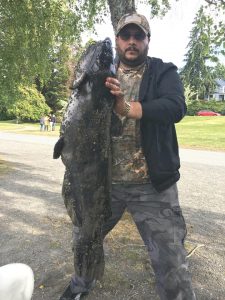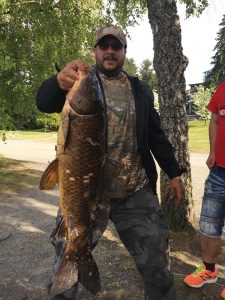Monster channel catfish and carp caught this past weekend at Green Lake in the heart of Seattle 1

Photo of a giant 45-pound channel catfish caught on June 9 in Green Lake in Seattle courtesy of Ahmed Majeed of Kent. He also landed a 30 pound carp on the same day.
It looks like the Washington Department of Fish and Wildlife’s (WDFW) channel catfish stocking plants that occurred at Green Lake in North Seattle and other statewide lakes and ponds more than two decades ago are paying off their dividends.
On Saturday, Ahmed Majeed of Kent was out on the lake for a day of fishing when he hooked into a 45-pound channel catfish and a 30-pound carp.
“I usually don’t fish Green Lake that much (and) one of the reasons I went there that day was a challenge,” Majeed said. “Most of the people I know kept saying – no fish in Green Lake or you can’t catch one in there other than trout.”
To avoid hooking smaller-sized fish, Majeed tied up a method feeder rig primarily used to catch carp and added a fake corn with carp scent above his hook.
He arrived around 10 a.m. at the lake, and caught the carp at noon, and then around 2 p.m. the giant catfish yanked at his bait.
“I was shocked,” Majeed said. “My first impression was “this is a huge Grass Carp” (until) I saw its head. It took me around 20 minutes to land it.”
After landing both fish it created a stir among curious by-passers from all over the lake who took pictures and videos of Majeed’s catch.

Ahmed Majeed of Kent holds up the big 30 pound carp he caught on June 9 in Green Lake in North Seattle.
Majeed weighed both fish on his own scale – which are now gutted and sitting in his freezer – but had it been done on a “official certified scale” the channel catfish would have easily shattered the current of 36.20 pounds caught by Ross Kincaid in the I-82 Pond Number 6 located in Yakima County on Sept. 6, 1999.
The state record for a common carp is 49.5 pounds caught by Duane Fish in Moses Lake on June 17, 2006.
Majeed still plans to take fish to WDFW officials.
Catfish in the Pacific Northwest don’t get the same respect as other fish like salmon or trout, but many anglers have found a fondness toward targeting these abundant species, which put up a decent fight and are very good tasting fish.
“We’ve had a concerted effort of planting channel catfish from the 1999 through 2005 in about 18 to 25 statewide lakes and one of them being Green Lake,” said Danny Garrett, a WDFW warm water fish biologist in Mill Creek who’d like to take a look at both of Majeed’s fish. “We’ve also been stocking fry and fingerling catfish since the 1990s, and the 8- to 11-inch fish we planted in the 2000s were purchased from an Arkansas supplier.”
Budget shortfall recently has hit the pause button on catfish planting but 51,000 were stocked in statewide lakes and ponds in 2011. Of those, Green Lake received a plant of 3,500 catfish.
WDFW began stocking channel catfish before 1988, and there was some intermittent planting in mid-1990s. Stocking efforts were revamped in 1999, and then discontinued from 2006 to 2010.
The first channel catfish were introduced to Washington in 1892 and are currently only known to naturally produce in the Snake, Columbia, Walla Walla and Yakima rivers.
“Channel catfish can live 20 to 25 years, and they just keep bigger and bigger with age,” Garrett said. “I thought we’d never see one get this big, but this just goes to show you that they’re a quality long-lived fish.”
A good effort during those early years of catfish planting occurred in eastern Washington at places like the Potholes Reservoir and Sprague Lake, which received decent-sized plants in 1999, 2005 and 2011 since both waterways some good fishing opportunities.
“We know in places like South Carolina a channel catfish can grown to 60 pounds, and this catch in Green Lake proves they can get that big,” Garrett said. “Looking at the picture that fish has got to be around four feet long.”
Prior to the budget cutbacks the last time lakes received plants was 2011.
They include: Green in King County; Campbell in Skagit; Gissburg and Powerline in Snohomish; Chambers and Swofford in Lewis; Fazon in Whatcom; Lawrence and St. Clair in Thurston; Potholes Reservoir and Stan Coffin in Grant; Kress in Cowlitz; Rotary, Sarge Hubbard and I-82 Ponds Number 1, 2, 3, 4, 6 and 7 in Yakima; Liberty in Spokane; McCabe in Kittitas; Scootney Reservoir in Franklin; Sprague in Lincoln; and Terrell in Whatcom.


“That’s BAD eatin’!”